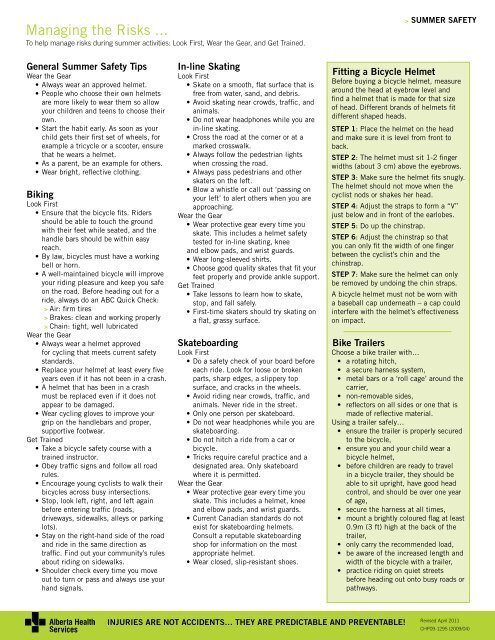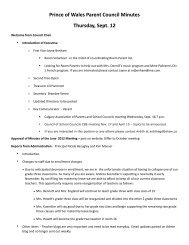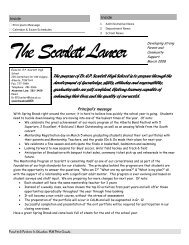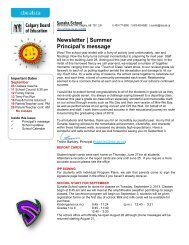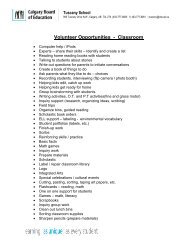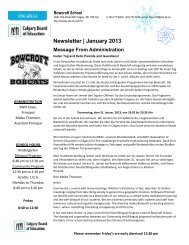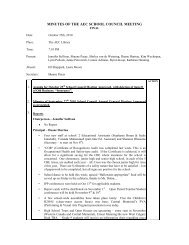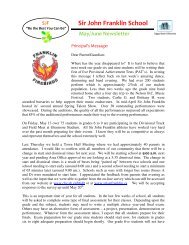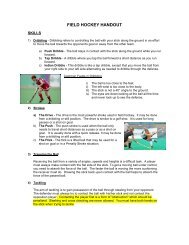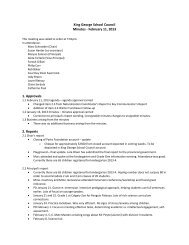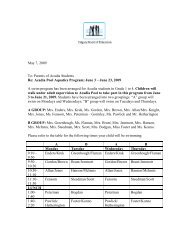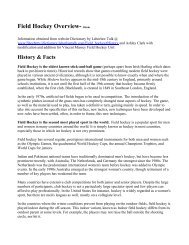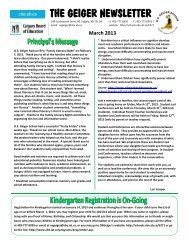HIGHWOOD SCHOOL - Calgary Board of Education
HIGHWOOD SCHOOL - Calgary Board of Education
HIGHWOOD SCHOOL - Calgary Board of Education
You also want an ePaper? Increase the reach of your titles
YUMPU automatically turns print PDFs into web optimized ePapers that Google loves.
Managing the Risks ...<br />
To help manage risks during summer activities: Look First, Wear the Gear, and Get Trained.<br />
General Summer Safety Tips<br />
Wear the Gear<br />
• Always wear an approved helmet.<br />
• People who choose their own helmets<br />
are more likely to wear them so allow<br />
your children and teens to choose their<br />
own.<br />
• Start the habit early. As soon as your<br />
child gets their first set <strong>of</strong> wheels, for<br />
example a tricycle or a scooter, ensure<br />
that he wears a helmet.<br />
• As a parent, be an example for others.<br />
• Wear bright, reflective clothing.<br />
Biking<br />
Look First<br />
• Ensure that the bicycle fits. Riders<br />
should be able to touch the ground<br />
with their feet while seated, and the<br />
handle bars should be within easy<br />
reach.<br />
• By law, bicycles must have a working<br />
bell or horn.<br />
• A well-maintained bicycle will improve<br />
your riding pleasure and keep you safe<br />
on the road. Before heading out for a<br />
ride, always do an ABC Quick Check:<br />
> Air: firm tires<br />
> Brakes: clean and working properly<br />
> Chain: tight, well lubricated<br />
Wear the Gear<br />
• Always wear a helmet approved<br />
for cycling that meets current safety<br />
standards.<br />
• Replace your helmet at least every five<br />
years even if it has not been in a crash.<br />
• A helmet that has been in a crash<br />
must be replaced even if it does not<br />
appear to be damaged.<br />
• Wear cycling gloves to improve your<br />
grip on the handlebars and proper,<br />
supportive footwear.<br />
Get Trained<br />
• Take a bicycle safety course with a<br />
trained instructor.<br />
• Obey traffic signs and follow all road<br />
rules.<br />
• Encourage young cyclists to walk their<br />
bicycles across busy intersections.<br />
• Stop, look left, right, and left again<br />
before entering traffic (roads,<br />
driveways, sidewalks, alleys or parking<br />
lots).<br />
• Stay on the right-hand side <strong>of</strong> the road<br />
and ride in the same direction as<br />
traffic. Find out your community’s rules<br />
about riding on sidewalks.<br />
• Shoulder check every time you move<br />
out to turn or pass and always use your<br />
hand signals.<br />
In-line Skating<br />
Look First<br />
• Skate on a smooth, flat surface that is<br />
free from water, sand, and debris.<br />
• Avoid skating near crowds, traffic, and<br />
animals.<br />
• Do not wear headphones while you are<br />
in-line skating.<br />
• Cross the road at the corner or at a<br />
marked crosswalk.<br />
• Always follow the pedestrian lights<br />
when crossing the road.<br />
• Always pass pedestrians and other<br />
skaters on the left.<br />
• Blow a whistle or call out ‘passing on<br />
your left’ to alert others when you are<br />
approaching.<br />
Wear the Gear<br />
• Wear protective gear every time you<br />
skate. This includes a helmet safety<br />
tested for in-line skating, knee<br />
and elbow pads, and wrist guards.<br />
• Wear long-sleeved shirts.<br />
• Choose good quality skates that fit your<br />
feet properly and provide ankle support.<br />
Get Trained<br />
• Take lessons to learn how to skate,<br />
stop, and fall safely.<br />
• First-time skaters should try skating on<br />
a flat, grassy surface.<br />
Skateboarding<br />
Look First<br />
• Do a safety check <strong>of</strong> your board before<br />
each ride. Look for loose or broken<br />
parts, sharp edges, a slippery top<br />
surface, and cracks in the wheels.<br />
• Avoid riding near crowds, traffic, and<br />
animals. Never ride in the street.<br />
• Only one person per skateboard.<br />
• Do not wear headphones while you are<br />
skateboarding.<br />
• Do not hitch a ride from a car or<br />
bicycle.<br />
• Tricks require careful practice and a<br />
designated area. Only skateboard<br />
where it is permitted.<br />
Wear the Gear<br />
• Wear protective gear every time you<br />
skate. This includes a helmet, knee<br />
and elbow pads, and wrist guards.<br />
• Current Canadian standards do not<br />
exist for skateboarding helmets.<br />
Consult a reputable skateboarding<br />
shop for information on the most<br />
appropriate helmet.<br />
• Wear closed, slip-resistant shoes.<br />
> SUMMER SAFETY<br />
Fitting a Bicycle Helmet<br />
Before buying a bicycle helmet, measure<br />
around the head at eyebrow level and<br />
find a helmet that is made for that size<br />
<strong>of</strong> head. Different brands <strong>of</strong> helmets fit<br />
different shaped heads.<br />
STEP 1: Place the helmet on the head<br />
and make sure it is level from front to<br />
back.<br />
STEP 2: The helmet must sit 1-2 finger<br />
widths (about 3 cm) above the eyebrows.<br />
STEP 3: Make sure the helmet fits snugly.<br />
The helmet should not move when the<br />
cyclist nods or shakes her head.<br />
STEP 4: Adjust the straps to form a “V”<br />
just below and in front <strong>of</strong> the earlobes.<br />
STEP 5: Do up the chinstrap.<br />
STEP 6: Adjust the chinstrap so that<br />
you can only fit the width <strong>of</strong> one finger<br />
between the cyclist’s chin and the<br />
chinstrap.<br />
STEP 7: Make sure the helmet can only<br />
be removed by undoing the chin straps.<br />
A bicycle helmet must not be worn with<br />
a baseball cap underneath – a cap could<br />
interfere with the helmet’s effectiveness<br />
on impact.<br />
Bike Trailers<br />
Choose a bike trailer with…<br />
• a rotating hitch,<br />
• a secure harness system,<br />
• metal bars or a ‘roll cage’ around the<br />
carrier,<br />
• non-removable sides,<br />
• reflectors on all sides or one that is<br />
made <strong>of</strong> reflective material.<br />
Using a trailer safely…<br />
• ensure the trailer is properly secured<br />
to the bicycle,<br />
• ensure you and your child wear a<br />
bicycle helmet,<br />
• before children are ready to travel<br />
in a bicycle trailer, they should be<br />
able to sit upright, have good head<br />
control, and should be over one year<br />
<strong>of</strong> age,<br />
• secure the harness at all times,<br />
• mount a brightly coloured flag at least<br />
0.9m (3 ft) high at the back <strong>of</strong> the<br />
trailer,<br />
• only carry the recommended load,<br />
• be aware <strong>of</strong> the increased length and<br />
width <strong>of</strong> the bicycle with a trailer,<br />
• practice riding on quiet streets<br />
before heading out onto busy roads or<br />
pathways.<br />
INJURIES ARE NOT ACCIDENTS… THEY ARE PREDICTABLE AND PREVENTABLE!<br />
Revised April 2011<br />
CHP09-1295 (2009/04)


